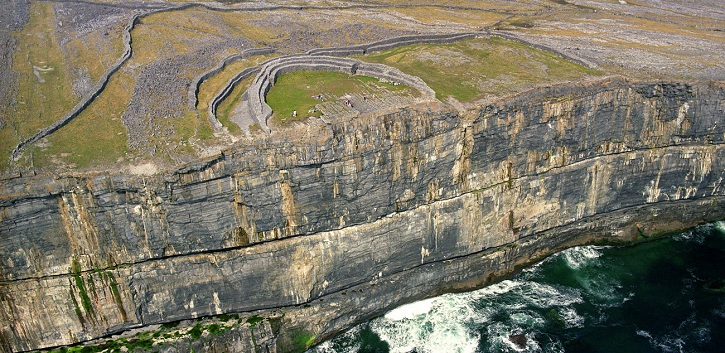2014 Press Releases
Climate change not to blame for collapse of Bronze Age

Scientists will have to find new reasons for the population collapse in Europe at the end of the Bronze Age as researchers prove that climate change could not have been the culprit.
Archaeologists and environmental scientists from University College Cork, (UCC), the University of Bradford, University of Leeds, and Queen’s University Belfast have shown that the changes in climate that scientists believed to coincide with the fall in population in fact occurred at least two generations later.
Their results, published today in Proceedings of the National Academy of Sciences, show that human activity starts to decline after 900BC, and falls rapidly after 800BC, indicating a population collapse. But the climate records show that colder, wetter conditions didn’t occur until around two generations later.
Fluctuations in levels of human activity through time are reflected by the numbers of radiocarbon dates for a given period. The team used new statistical techniques to analyse more than 2000 radiocarbon dates, taken from hundreds of archaeological sites in Ireland, to pinpoint the precise dates that Europe’s Bronze Age population collapse occurred.
“We are in the lucky position to have in Ireland a large set of well-dated sites that were excavated during the years of the Celtic Tiger in order to facilitate road, pipeline and housing developments. From an archaeological perspective, this selection of sites effectively provides a representative sample of past activity across the country” says Dr Katharina Becker of UCC’s Archaeology Department.” Dr Becker is a lecturer in the Department of Archaeology in UCC and specialises in the Archaeology of Late Bronze Age and Iron Age Ireland.
The team then analysed past climate records from peat bogs in Ireland and compared the archaeological data to these climate records to see if the dates tallied. That information was then compared with evidence of climate change across NW Europe between 1200 and 500 BC.
“Our evidence shows definitively that the population decline in this period cannot have been caused by climate change,” says Ian Armit, Professor of Archaeology at the University of Bradford, and lead author of the study.
Graeme Swindles, Associate Professor of Earth System Dynamics at the University of Leeds, added, “We found clear evidence for a rapid change in climate to much wetter conditions, which we were able to precisely pinpoint to 750BC using statistical methods.”
According to Professor Armit, social and economic stress is more likely to be the cause of the sudden and widespread fall in numbers. Communities producing bronze needed to trade over very large distances to obtain copper and tin. Control of these networks enabled the growth of complex, hierarchical societies dominated by a warrior elite. As iron production took over, these networks collapsed, leading to widespread conflict and social collapse. It may be these unstable social conditions, rather than climate change, that led to the population collapse at the end of the Bronze Age.
According to Dr Becker, the Late Bronze Age is usually seen as a time of plenty, in contrast to an impoverished Early Iron Age. “Our results show that the rich Bronze Age artefact record does not provide the full picture and that crisis began earlier than previously thought,” she says.
“Although climate change was not directly responsible for the collapse it is likely that the poor climatic conditions would have affected farming,” adds Professor Armit. “This would have been particularly difficult for vulnerable communities, preventing population recovery for several centuries.”
The findings have significance for modern day climate change debates which, argues Professor Armit, are often too quick to link historical climate events with changes in population.
“The impact of climate change on humans is a huge concern today as we monitor rising temperatures globally,” says Professor Armit. “Often, in examining the past, we are inclined to link evidence of climate change with evidence of population change. Actually, if you have high quality data and apply modern analytical techniques, you get a much clearer picture and start to see the real complexity of human/environment relationships in the past.”
ENDS
Further information
- “Rapid climate change did not cause population collapse at the end of the European Bronze Age”, by Ian Armit, Graeme Swindles, Katharina Becker, Gill Plunkett and Maarten Blaauw,is published in Proceedings of the National Academy of Sciences in the week beginning 17 November 2014.
UCC has been a centre for the study of Archaeology since 1909. The Department has grown steadily over the past century, acquiring a reputation for excellence in teaching and research. Their research strengths include physical anthropology and bioarchaeology, architectural heritage, prehistory and early medieval studies. The Department is known for innovative fieldwork, going back to Professor Sean P. Ó Riordáin’s work at Lough Gur and Professor Michael O’Kelly’s excavation of Newgrange and other major sites in Ireland.
Ireland offers particularly rich opportunities to study archaeological records, partly because of the quality of palaeoenvironmental samples from the country’s peat bogs, and partly because of a huge upsurge in archaeological excavations in Ireland during the economic boom between 1995 and 2008.
